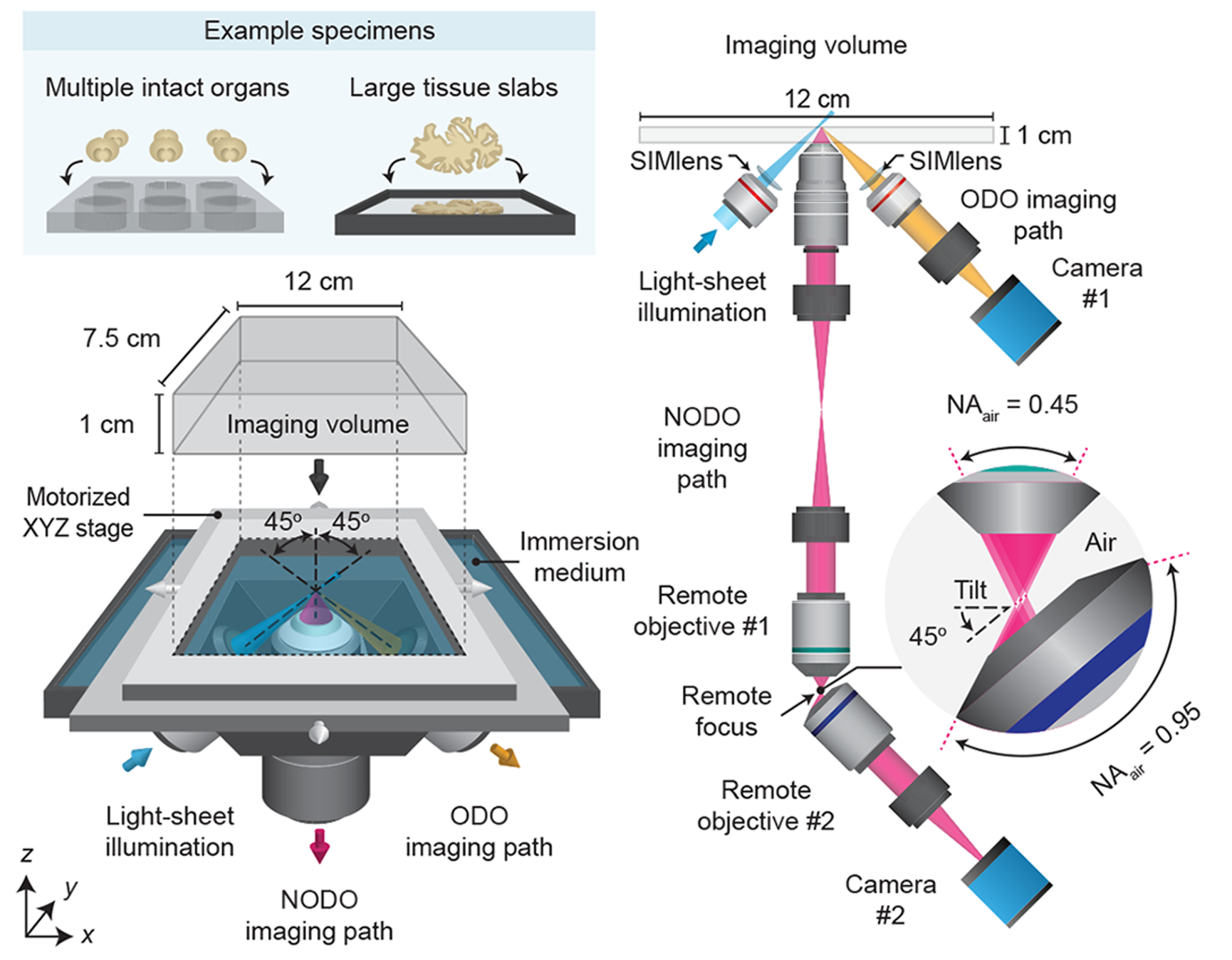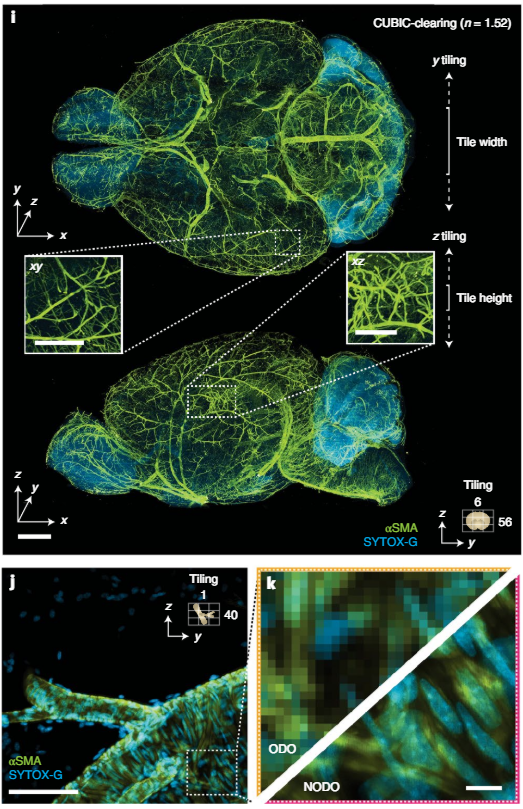3Di™ Hybrid Open-Top Light-Sheet Microscope for fast whole tissue imaging with high resolution zoom
What is Light-Sheet Microscopy
Light sheet microscopy is an advanced method for fast volumetric imaging. It illuminates the specimen with a thin sheet of light that excites only the in-focus plane, while a camera captures each optical section at high speed. This selective illumination limits photodamage and preserves clarity in thick tissues. It also allows rapid acquisition of high-contrast data across large volumes.
The technique is well-suited for 3D tissue imaging, whole-organ surveys, organoids, embryos, and other samples that challenge the capabilities of wide-field or confocal systems. By exciting only a single optical section at a time, light sheet microscopy minimizes bleaching, supports gentle live imaging, and generates datasets that are ideal for 3D histology, digital pathology, 3D spatial biology, and quantitative tissue analysis at scale.
Even with these advantages, standard light sheet designs struggle to achieve both ample volume coverage and subcellular resolution, particularly when samples vary significantly in size, geometry, and refractive index. Researchers often face a familiar choice: whole sample speed or fine detail, flexible mounting or high optical performance.
“Alpenglow Biosciences created the 3Di Hybrid Open Top Light Sheet microscope to resolve this limitation. The system provides rapid whole-tissue scouting and targeted high-resolution zoom on the same instrument, and its open-top architecture supports simple, repeatable handling across diverse specimens. The goal is to deliver complete morphology and true spatial context without sacrificing resolution, throughput, or sample integrity.”
What “hybrid open-top light-sheet” means, and why it matters
Traditional light-sheet microscopes place objectives around the sample, which restricts the sample size and complicates mounting. Open-top systems invert this geometry, placing the optics below the specimen. Alpenglow’s hybrid architecture builds on this idea, integrating two coordinated light sheet paths.
• The orthogonal open top path provides fast, wide field scouting across large cleared samples.
• The non-orthogonal dual objective path provides submicrometer zoom with high numerical aperture collection.
The two paths work together. Users can quickly screen large volumes, identify regions of interest, and then re-image specific sites at much higher resolution without changing microscopes or altering sample mounting.
The hybrid concept was introduced and validated in Nature Methods in 2022. The paper describes the non-orthogonal dual-objective (NODO) path, remote refocusing to correct a tilted light sheet, and multi-scale workflows, all of which are demonstrated on intact mouse brains and metastatic lesions.
Before that, the team established the open-top foundation with multi-immersion optics for cleared tissues in Nature Communications in 2019, addressing practical mounting, compatibility with many clearing protocols, and high-throughput imaging. These engineering choices are core to today’s product, the 3Di™.
Hybrid light sheet geometry for wide area scouting and high resolution zoom
The hybrid microscope architecture consists of three objectives positioned below the specimen. One objective is used for light-sheet illumination, and the other two objectives are used for orthogonal dual-objective (ODO) and non-orthogonal dual-objective (NODO) imaging. By using a motorized stage, tiled imaging is possible with both paths over a large 12 × 7.5 × 1 cm (XYZ) imaging volume, accommodating multiple intact cleared organs and large tissue slabs mounted in an array of specimen holders.
What you can expect from the 3Di™ HOTLS
Two imaging modes on one instrument
Scout (ODO path) for rapid, low-resolution whole-sample surveys and navigation.
Zoom (NODO path) for localized, high-resolution imaging of regions identified during Scout.
Users switch between Scout and Zoom in the same imaging session inside the LUMI interface.
“LUMI is the microscope’s GUI for setup, acquisition, and live monitoring. It supports:
- Intuitive scan setup, so operators configure trays, tiles, and channels quickly.
- Simultaneous live previews in Scout and Zoom, which helps position ROIs and verify focus before committing to long scans.
- A clean, easy interface usable by new and advanced users, with a “see it working” preview”
Large imaging volume with open-top convenience
Tiled imaging over up to ~12 × 7.5 × 1 cm volumes, suitable for multi-sample trays, large organs, or arrays of biopsies.
Open-top holders keep cleared specimens stable by gravity and light compression, while separating immersion and clearing solutions for easier handling.
Resolution and optics at a glance
Zoom path pixel sampling on the order of ~170 nm per pixel, with collection NA up to 0.7 for sub-micrometer detail.
Scout path wide field surveying with pixel sampling around ~2 µm per pixel, used to find and queue ROIs for Zoom.
Multi-immersion optics spanning refractive indices ~1.33 to 1.56 to match common clearing media. 3Di™ HOTLS Alpenglow
This level of sampling corresponds to the practical confocal resolution achieved within a light sheet workflow that maintains speed and minimizes photobleaching.
Throughput and automation
A motorized stage enables raster tiling across large trays, including multi-well plates and multi-specimen formats such as arrays of mouse brains. Multi-sample workflows are fully automated, featuring cloud-based upload, flat-fielding, stitching, registration, and AI-ready outputs.
Comparing Scout and Zoom resolution
i, Representative ODO imaging results of an entire intact CUBIC-cleared mouse brain with arterial (αSMA) and nuclear (SYTOX-G) staining. The ODO imaging path is able to clearly resolve vasculature in both the xy and xz planes (insets). The size and direction of tiling is annotated. j,k, Targeted NODO imaging of a sub-region centered on a branching arteriole resolves individual smooth muscle cells and sub-nuclear features that are not resolved by ODO imaging. Scale-bar lengths are as follows: i, 1mm (insets, 500 μm); j, 100 μm; and k, 10 μm.
Broader applicability across research, translational, and clinical programs
The 3Di™ system is designed not only for research but also for translational and clinical environments where the analysis of intact human tissue is essential. Applications include human biopsy imaging, 3D pathology for inflammatory skin disease, tumor microenvironment mapping, and non-destructive workflows that preserve precious specimens for sequencing or IHC. This breadth makes the system relevant for academic research labs, core facilities, translational groups, and early-stage clinical programs that require full tissue context and quantitative 3D readouts.
As an example of clinical impact, nondestructive 3D pathology has been used for patient risk stratification in prostate cancer, as demonstrated in the study “Prostate Cancer Risk Stratification via Nondestructive 3D Pathology with Deep Learning Assisted Gland Analysis” (Cancer Research, 2022).
From imaging to answers: 3Di™, 3Dm™, and 3Dai™
Alpenglow Biosciences positions the microscope within an end-to-end platform:
3Di™ for 3D image acquisition,
3Dm™ for data management and correction,
3Dai™ for quantitative analysis, including counts, shapes, distances to vessels, segmentation, and spatial correlations.
This pipeline is designed for non-destructive 3D pathology, preserving tissue for downstream assays and enabling larger, decision-grade volumetric datasets.
Typical samples and clearing compatibility
The instrument was engineered around cleared tissue imaging across protocols with different refractive indices. The open-top layout accepts whole organs, biopsies, organoids, and multi-well plates, with customizable holders to match geometry and workflow. The multi-immersion objective design and open-top mounting were created specifically to accommodate this variety.
Selected example workflows among applications
Whole-organ survey with targeted ROI quantification
Scout the full organ, mark ROIs, then Zoom to quantify axonal density, vascular branching, or tumor invasion margins in situ, as demonstrated in the 2022 Nature Methods paper on intact brain and brain metastasis models. NatureBiopsy-scale 3D pathology with preserved tissue
Image intact biopsies, run 3Dai™ analyses for counts, shapes, and distances, then keep the specimen for sequencing or IHC. The non-destructive approach and data-processing pipeline are described in the 2021 Perspective. NatureHigh-throughput cleared tissue screens
Load multi-sample trays, run automated tiling and cloud correction, and export stitched volumes for downstream AI. This high-throughput use case builds directly on the multi-immersion open-top design reported in 2019. Nature
Key specifications and capabilities
Imaging volume: up to ~12 × 7.5 × 1 cm tiled volume per run.
Dual paths: Scout for speed, Zoom for sub-micrometer detail.
Pixel sampling: ~2 µm per pixel in Scout, ~170 nm per pixel in Zoom.
Collection NA: up to 0.7 on the Zoom path.
Lasers: standard 405, 488, 561, 638 nm (customizable)
Multi-immersion range: n ≈ 1.33 to 1.56.
End-to-end pipeline: integrated upload, corrections, registration, and quantitative 3D analytics.
For a product overview and screenshots of the LUMI interface, see the HOTLS page: https://www.alpenglowbiosciences.com/3di-hotls-microscope
How it fits into your lab or program
Alpenglow supports different engagement models, from imaging services and pilot projects to placing a full solution on-site with training and support. The FAQ and site overview describe the combined hardware, software, and services approach for research, translational studies, and early clinical investigations.
Where to learn more
Product page: 3Di™ Hybrid Open-Top Light-Sheet Microscope.
Brochure with specs and workflow diagrams, including imaging volume, multi-immersion optics, Scout and Zoom details, and analysis examples. 3Di™ HOTLS Alpenglow
Peer-reviewed papers that underpin the system
Glaser et al., Nature Methods 2022, hybrid HOTLS with NODO and remote refocusing, multi-scale imaging demonstrations. Nature
Glaser et al., Nature Communications 2019, multi-immersion open-top design for cleared tissues and high-throughput workflows. Nature
Liu, Glaser, Madabhushi, Nature Biomedical Engineering 2021, Perspective on non-destructive 3D pathology and its computational stack. Nature
Use-case posts that contrast 3D with 2D: Alpenglow Biosciences
The 3Di™ HOTLS delivers what many groups have wanted from light-sheet imaging, a practical way to combine whole-sample context with sub-cellular detail, while keeping the tissue intact and the workflow scalable. If your questions require complete morphology, true spatial relationships, and quantitative 3D readouts, a hybrid open-top approach is worth serious consideration.


